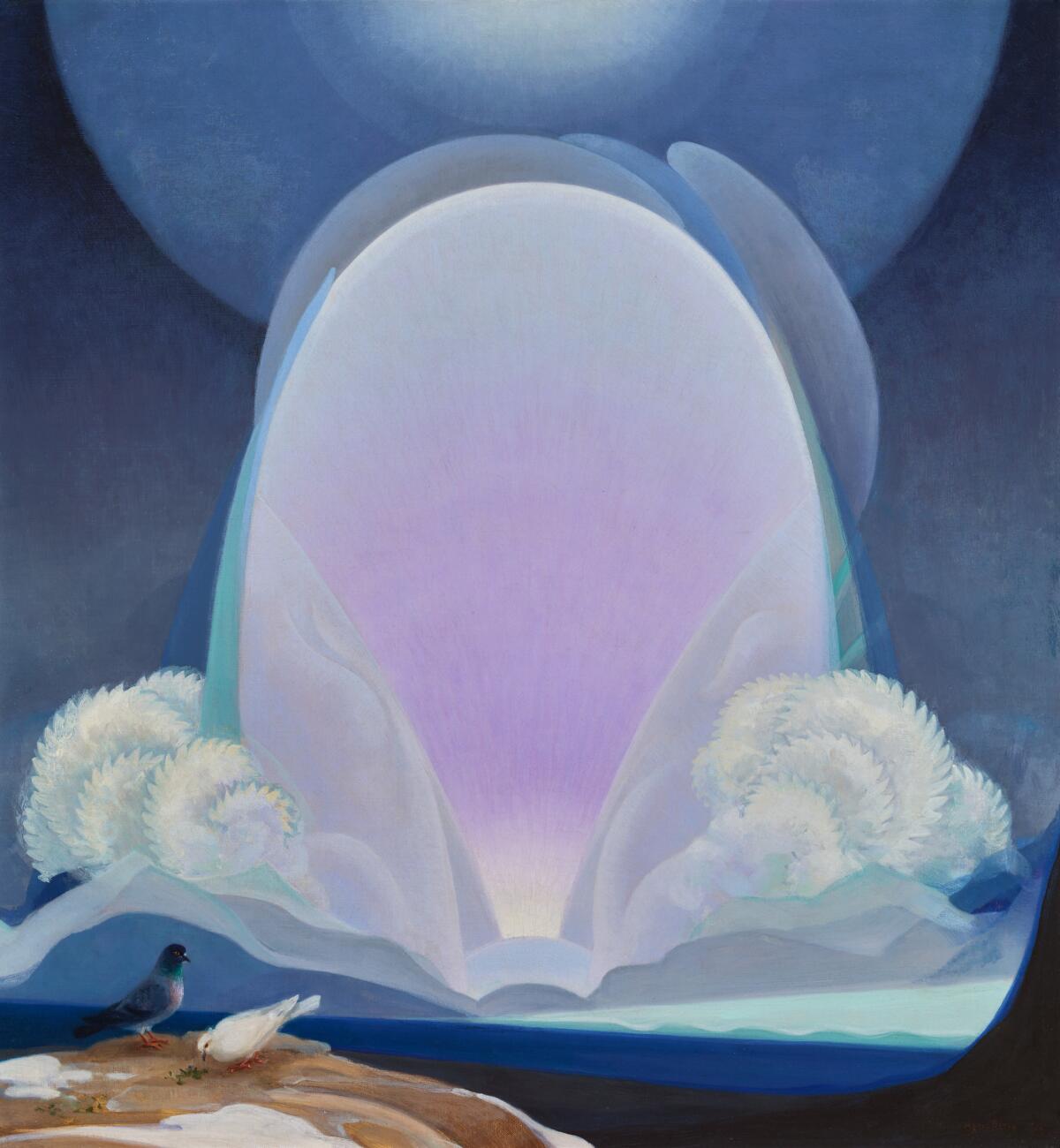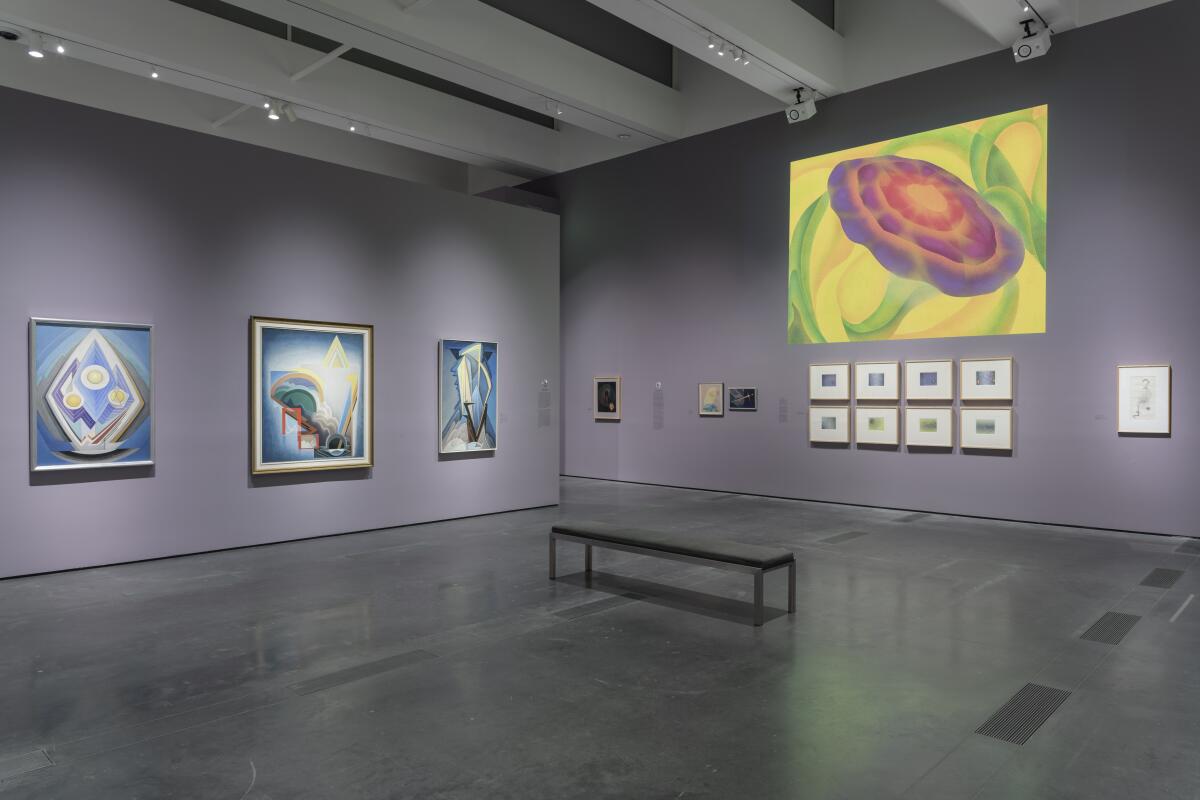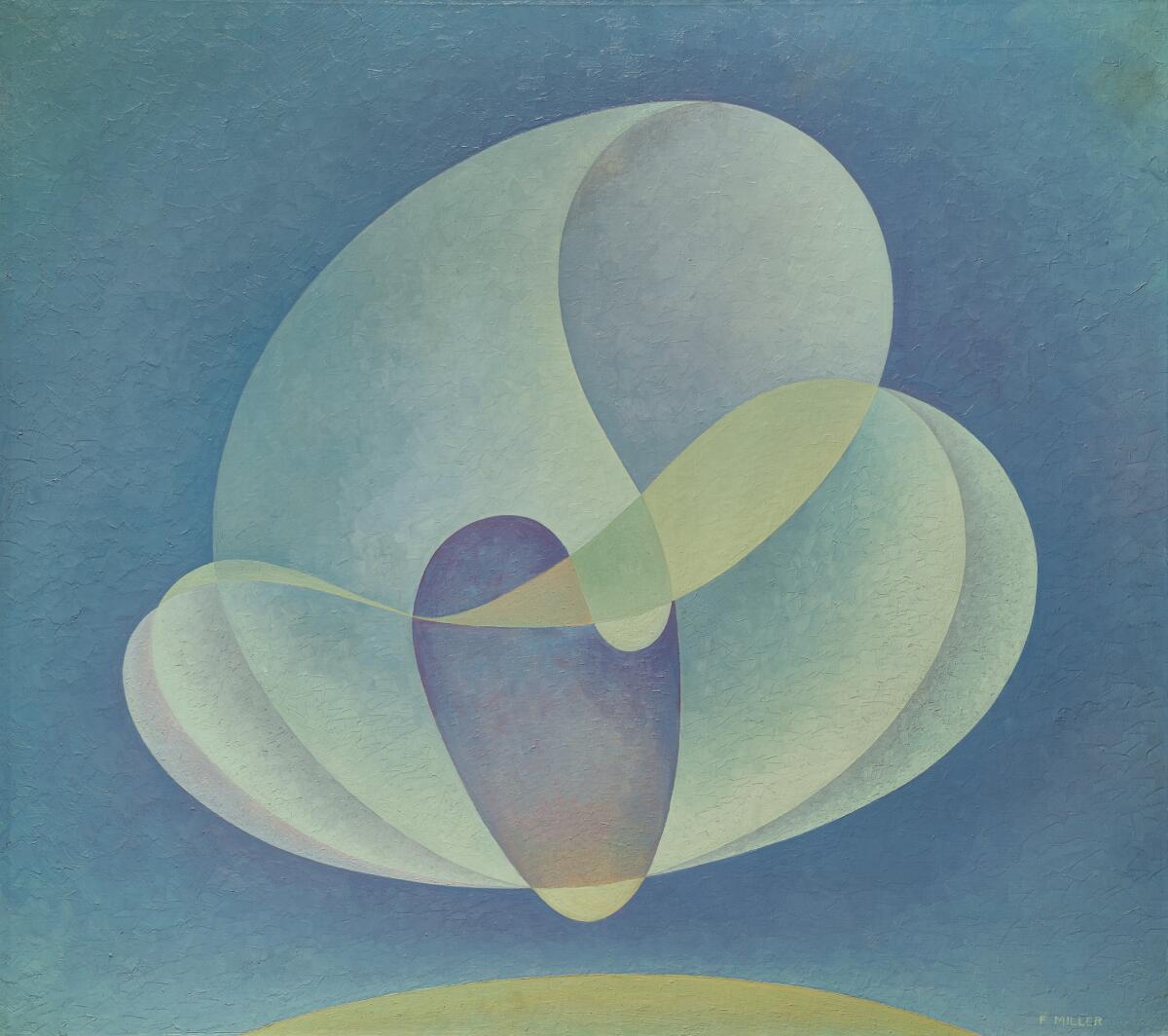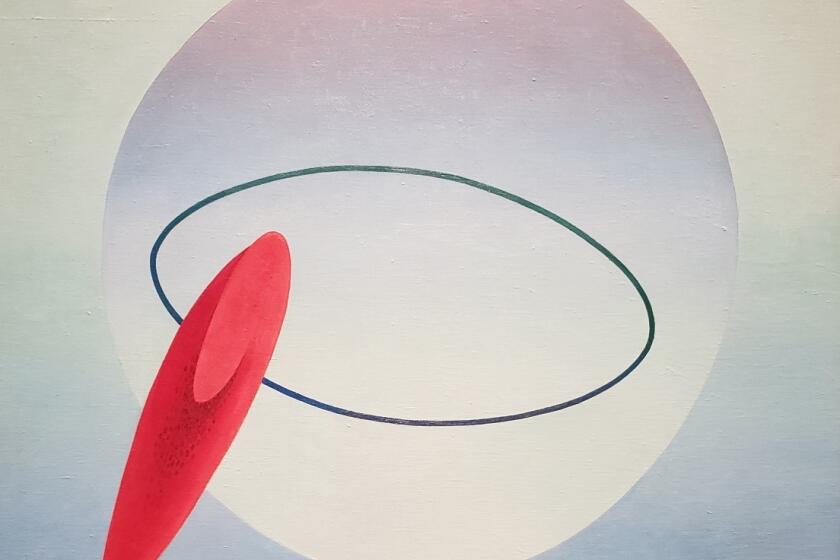How a group of abstract painters in New Mexico — and the U.S. government — changed modern art

- Share via
Isolated in the rural American Southwest and navigating the harsh realities of poverty in the 1930s, a small group of artists made sublime abstract art that sought to intuitively connect viewers to a spiritual realm. These artists gathered in an adobe home in Santa Fe, N.M., in the summer of 1938 to formalize their commitment to a collective effort of art-making with metaphysical motivations. They named it the Transcendental Painting Group.
Combining Eastern philosophies and cosmologies of European occultism with symbolism, symmetry, light, color and design as their tools, they existed wildly outside the representational artwork prevalent throughout the West and pushed beyond trailblazers in non-objective art such as Wassily Kandinsky and Alfred Stieglitz.
“Another World: The Transcendental Painting Group” at the Los Angeles County Museum of Art through June 19 is the first comprehensive exhibition to include all the artists from the TPG: Agnes Pelton, Raymond Jonson, Emil Bisttram, William Lumpkins, Lawren Harris, Florence Miller Pierce, Ed Garman, Horace Towner Pierce, Robert Gribbroek, Stuart Walker and Dane Rudhyar. What’s not as visible at the show is how the Works Progress Administration shaped TPG artists’ awareness of art’s capacity to enlighten audiences.
‘Another World: The Transcendental Painting Group’ at LACMA presents an overdue survey of the abstract painting movement started in New Mexico.
The WPA was a federal work-relief program for artists of all mediums during the Depression. By placing artists in service of public venues, both urban and rural, it demystified creative labor and brought local residents in dialogue with the insular community of artists. This engagement, which was not happening in galleries and museums, fostered the radical belief among the Transcendentalists that if artists were doing their job, viewers could access a portal to understanding nature, music and self — a fourth dimension on a two-dimensional surface. The art of the TPG was not escapism, but rather a means to see beyond the limitations of the present.
The heart of the Transcendentalists was Pelton. When Pelton exhibited her work at the 1913 Armory Show in New York, she was invited by one of its organizers, Mabel Dodge, to visit her Taos, N.M., ranch in 1918. Pelton stayed for three winter months that year and returned again in 1919, painting landscapes and portraits before she returned East.
Pelton’s figures from Taos float in space without context or even a completed form. The definitive line of a horse’s spine or a face softly framed by a veil, for instance, fades at the edges like a thinning thread. The result is a sense of time passing, despite the static nature of the medium. Within a few years of that encounter, she transitioned to pure abstraction; the work vibrated with light and had no compositional comparison.
Jonson, who moved to Santa Fe in 1924 from Chicago, knew of Pelton’s paintings only through descriptions. He eventually arranged a three-person show to include Pelton and, when her paintings arrived, he wrote Bisttram that if he had to walk the 70 miles from Taos, it would be worth it.
Neither Jonson or Bisttram was as far along as Pelton in philosophy or form when they encountered her work, but abstract art in America was not mainstream at the time. Only two Americans were exhibited in the Museum of Modern Art’s 1936 show “Cubism and Abstract Art,” and no abstract work was included in the museum’s 1938 show “Three Centuries of American Art.” Jonson wrote Pelton in 1933, “there are so few of us who work in the abstract … we are not heard.”
Palm Springs Art Museum reopens with desert heroine Agnes Pelton, who deserves a place alongside Georgia O’Keeffe among early American Modern artists.
Why would artists exploring abstraction relocate to rural New Mexico? Many artists attempted to interpret the ceremonies and visual culture of the thriving Native American tribes in the state. TPG artists, such as Bisttram, emphasize in their writing that movement, spirituality and abstraction within Indigenous art were their motivating subjects compared to previous generations that illustrated Wild West stories for publications like Harper’s Weekly and Collier’s.
The desert light and contrasting colors of purple candlewood blossoms and yellow sagebrush among the Sangre de Cristo mountains also attracted artists from across the Mississippi. “Nature here is so strong that one has to be on one’s guard to not be absorbed by it,” wrote Dodge.
What that romantic observation excluded was the attractive affordability. There was no electricity in Taos or indoor plumbing, the roads were mud and only one telephone in town was wired to the outside world. A house with 50 acres could rent for $125 a year.
After the stock market crash of 1929, Jonson opened an art supply store in his garage to supplement his income, and at age 51, Pelton moved to Cathedral City in the California desert. Garman, who just graduated high school, noticed that everyone, including doctors and lawyers, were unemployed. He came to Albuquerque from Pennsylvania because the University of New Mexico offered tuition, room and board for $25 a month.
Bisttram’s commercial art business in New York collapsed. Seeking a less expensive residence, he arrived in Taos in 1931 and founded the Taos School of Art in his home. Early in 1933, he journaled that he sold a watercolor for $57, which included the service of seven critiques of the buyer’s own artwork. “A lot lost in the stock market, like everyone else,” he wrote, “and of course very little chance of selling paintings. 1933 may be even worse.”
The Public Works of Art Project was born in 1933 when President Roosevelt created an executive order of the Civil Works Administration. The aim was to put unemployed artists to work in public buildings and parks at a skill-based pay scale of $26.50 to $42.50 a week. In 1935 the Works Progress Administration established the Federal Art Project, which took over for the PWAP until 1943. Of the initial 2,500 American artists in the program, 160 resided in New Mexico, including many artists who later joined the TPG.

Gustave Baumann, a printmaker, was the regional director in New Mexico tasked with evaluating artists and maintaining project progress reports.
Baumann’s archived writings reveal the challenges of the program, such as the 40 miles he drove in a day just to visit the studios of artists around Santa Fe who often weren’t home to receive him. It also grants insight to the prevalent attitude toward art at the time, such as his 1934 report on painter Charles Berninghaus’ progress at a library: “a conceited young ass, altogether overcome by his own importance — had to be put in his place and handled rough.” In a later notation, Baumann suggests dropping Berninghaus from the program after the artist expressed displeasure with the low pay.
That same year, Baumann approved the completion of Bruce Wilder Saville’s bronze monument for the National Cemetery in Santa Fe as an “acceptable thing to hang wreaths on.” While carving a wooden coat of arms for the State Museum Library, Irene Emery received this feedback: “an unhappy victim of the suffrage idea — she should be a woman first and last, but aspires to be a dancer, sculptor or perhaps anything to escape female responsibility.”
Jonson completed six WPA murals before accepting a position to teach at the University of New Mexico. Garman joined WPA-funded archeological digs at ancient pueblos in the Rio Grande Valley sorting pottery shards. “I was saturated with patterns and arrangements,” he wrote.
Bisttram won several WPA commissions, including the Taos County Courthouse, a project for which he petitioned to add more colleagues because he valued working with a group. In 1934, he received a letter from Edward Bruce, secretary of the Treasury, thanking him for his participation in the PWAP and FAP: “We should all recognize that art is an expression of national culture and that it takes artists of all schools and types to make this expression a rounded one,” he wrote. “Artists of every country remain, in the last analysis, the true measure of its civilization.”
Sustaining as an artist in the Depression was, to Garman, “the ultimate in an irrational hope and a guarantee of economic and social suicide.”
Still, although the painting style of social realism was prevalent in the WPA, all artists found they were no longer outsiders. Communities observed the process of art-making in their local post office or school, which encouraged conversations with artists to stretch over many months.

A 1937 Fortune magazine article wrote, “They [the WPA] brought the American audience and the American artists face to face for the first time in their respective lives.” The class condescension created by the myth that art was for the rich was now challenged.
“I’m not interested in telling the farmer and politician about our country,” wrote Jonson in 1937, “but rather in telling all about the wonders of a richer and deeper land — the world of peace — love and human relations projected through pure form.”
The government’s experiment stirred a collective consciousness that art was not about a personal pursuit or materialist effort. Art could resonate a universal experience beyond the visible world.
At that 1938 meeting in Santa Fe, Bisttram invited his students Miller and Pierce, and Gribbroek and Jonson brought Harris, Lumpkins, Walker and Garman. Pelton never attended a meeting but was elected honorary president, signaling the group’s acknowledgment that she was already expressing ideas they sought to promote.
The TPG is not referred to as a movement because it did not expand its reach due to the onset of the second World War. Bisttram, Jonson and others made their most incredible work during the group’s existence, which successfully established a unique art form with roots in the American West.
More to Read
The biggest entertainment stories
Get our big stories about Hollywood, film, television, music, arts, culture and more right in your inbox as soon as they publish.
You may occasionally receive promotional content from the Los Angeles Times.











